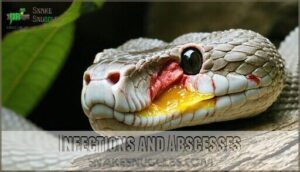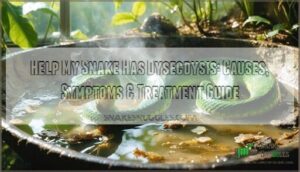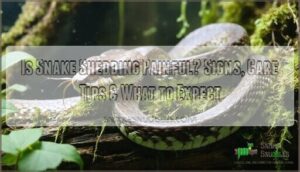This site is supported by our readers. We may earn a commission, at no cost to you, if you purchase through links.
 You’ll spot common snake health issues through changes in eating habits, skin problems, breathing difficulties, and unusual behavior.
You’ll spot common snake health issues through changes in eating habits, skin problems, breathing difficulties, and unusual behavior.
Respiratory infections show up as mouth breathing or wheezing, while shedding problems create stuck skin patches that can cut off circulation.
Digestive blockages cause regurgitation and lethargy, and parasites like mites appear as tiny moving dots on your snake’s skin.
Environmental factors often trigger these conditions – improper temperatures, humidity levels, or dirty enclosures create stress that weakens your snake’s immune system.
Most issues stem from husbandry mistakes rather than serious diseases, making prevention through proper care your best defense.
Understanding these warning signs can mean the difference between a quick recovery and a life-threatening emergency.
Table Of Contents
- Key Takeaways
- Common Snake Health Issues
- Snake Skin Problems
- Snake Injuries and Wounds
- Snake Digestive Issues
- Snake Respiratory Problems
- Snake Eye and Ear Disorders
- Snake Heart and Blood Vessel Disorders
- Snake Hormonal and Nutritional Disorders
- Snake Reproductive and Developmental Issues
- Recognizing Signs of Illness in Snakes
- Frequently Asked Questions (FAQs)
- How to tell if your snake is unwell?
- How to tell if a snake has a respiratory infection?
- Do snakes carry a lot of diseases?
- What are signs of discomfort in snakes?
- What does an unhealthy snake look like?
- How to tell if your snake is healthy?
- What are the symptoms of a snake blockage?
- How can I prevent my snake from escaping its enclosure?
- What are the benefits of regular veterinary check-ups for snakes?
- Can I handle my snake when its showing signs of illness?
- Conclusion
Key Takeaways
- You’ll catch most problems early by watching for behavioral changes – appetite loss, lethargy, unusual hiding, and breathing difficulties signal trouble before it becomes serious
- Environmental factors cause most snake health issues – improper temperatures, humidity levels, and dirty enclosures create stress that weakens your snake’s immune system
- Respiratory infections show obvious warning signs – look for mouth breathing, wheezing, nasal discharge, and gurgling sounds that demand immediate veterinary attention
- Prevention through proper husbandry beats treatment – maintaining correct temperatures, humidity, cleanliness, and quarantine protocols prevents most common snake diseases from developing
Common Snake Health Issues
Snake health problems can sneak up on you faster than you’d expect, making early detection essential for your pet’s wellbeing.
Understanding common issues like appetite loss, skin problems, and respiratory infections helps you spot trouble before it becomes serious.
Anorexia in Snakes
When your snake refuses to eat, snake anorexia signals trouble ahead.
A snake that won’t eat is telling you something’s seriously wrong.
This snake health issue affects their balanced diet** and overall wellbeing.
Refusal causes include environmental stressors, prey preference shifts, and underlying diseases.
Changes in appetite demand immediate attention—prolonged fasting weakens immune systems and triggers secondary complications.
Early veterinary intervention prevents serious health consequences from developing.
Identifying The Causes of Anorexia
When your snake won’t eat, you’re facing a detective case with multiple suspects.
Underlying diseases like mouth rot or internal parasites often trigger snake anorexia causes. Improper husbandry creates environmental stressors that suppress appetite.
Dietary imbalance from oversized prey compounds the problem. Reproductive cycles and seasonal changes also affect snake behavior.
Identifying the root cause requires examining snake health issues systematically to restore your pet’s normal snake diet patterns. Prolonged anorexia, or loss of appetite, can indicate serious underlying health issues in snakes.
Environmental Factors Affecting Appetite
Something’s bothering your snake’s appetite? Environmental factors often hold the key to solving snake anorexia causes.
Your snake’s enclosure maintenance directly impacts their willingness to eat, making proper environmental factors essential for healthy snake diet habits.
- Temperature Impact: Incorrect heating disrupts metabolism and digestion
- Humidity Effects: Wrong moisture levels create stress factors affecting appetite
- Enclosure Size: Cramped spaces increase snake stress and reduce feeding
- Lighting Influence: Poor light cycles confuse natural feeding rhythms
Diseases and Conditions Leading to Anorexia
Disease-related appetite loss stems from various infection-related anorexia triggers that disrupt your snake’s normal feeding patterns.
Parasite-induced anorexia weakens snakes substantially, while organ failure and neoplasia create systemic problems affecting digestion.
| Condition Category | Common Examples | Key Symptoms |
|---|---|---|
| Infections | Stomatitis, respiratory infections | Poor appetite, lethargy, visible inflammation |
| Parasites | Internal worms, external mites | Weight loss, snake regurgitation reasons, anemia |
| Systemic Issues | Organ failure, neoplasia | Gradual decline, changes in appetite, weakness |
| Neurological | Neurological disorders, spinal issues | Difficulty swallowing, abnormal posturing, feeding refusal |
Snake digestive problems and snake health issues often interconnect, creating cascading effects that worsen appetite loss over time.
Snake Skin Problems
Your snake’s skin health directly reflects its overall well-being, and problems can range from minor shedding difficulties to serious infections that require immediate attention.
Understanding these common skin issues will help you spot trouble early and take the right steps to keep your scaly friend healthy.
Shedding Issues and Dysecdysis
Normal shedding keeps your snake healthy, but dysecdysis creates serious problems. When old skin won’t come off properly, you’re dealing with snake shedding problems that need immediate attention.
Retained eyecaps pose the biggest threat, potentially causing permanent eye damage.
Here’s how to prevent shedding problems:
- Maintain proper humidity levels for your species
- Monitor shedding frequency – healthy snakes shed every 4-8 weeks
- Guarantee adequate nutritional impact through proper feeding
- Implement preventative measures like humid hides
Snakes require optimal enclosure humidity to facilitate proper shedding.
Dysecdysis treatment often requires veterinary intervention, especially for eye cap retention around the eyes.
Lumps and Bumps on The Skin
Various lumps and bumps can appear on your snake’s skin, ranging from harmless cysts to serious tumors requiring immediate attention.
Abscess identification involves looking for firm, swollen areas that may rupture, and cyst types include sebaceous and inclusion cysts.
Scale abnormalities and hematoma causes often stem from trauma or infections, making proper skin disease assessment essential, including veterinary examination for tumor diagnosis.
Infections and Abscesses
Beyond surface bumps lies a more serious concern: snake infections and abscesses. These painful conditions develop when bacteria or fungi invade through wounds, poor hygiene, or compromised immunity. You’ll notice firm swellings, often containing thick, cheesy pus that requires immediate attention.
Key signs of snake infections include:
- Swollen, firm masses on the head, mouth, or body filled with caseous material
- Foul odors and discharge from wounds or the oral cavity
- Red, inflamed skin with possible oozing or blistering around affected areas
- Lethargy and appetite loss as the infection spreads systemically
- Mouth rot symptoms like thick mucus, gum swelling, and oral ulcerations
Effective wound management starts with surgical abscess drainage under veterinary supervision. Antibiotic use targets bacterial infections, while fungal infections like scale rot need antifungal treatment. One such fungal issue to watch for is snake fungal disease, which can be devastating.
Preventative hygiene through proper enclosure cleaning prevents most skin infections from developing initially.
Parasites and Mites
Mite infestations and internal parasites pose serious threats to your snake’s wellbeing.
Look for tiny black dots around eyes and mouth, plus external parasites causing skin irritation.
Snake mite infestation spreads quickly, creating zoonotic risks for you too.
Combat these pests with warm water baths and tank disinfection.
Antiparasitic treatment from your vet tackles stubborn cases.
Parasite prevention starts with quarantining new snakes and maintaining spotless enclosures—your snake’s health depends on it.
Snake Injuries and Wounds
Physical injuries can happen to your snake from heat sources, rough handling, or cage hazards, leading to burns, cuts, and facial trauma.
Quick identification and proper wound care are essential to prevent serious infections and guarantee your snake’s recovery.
Burns and Thermal Injuries
Burns pose serious risks to your snake’s health and require immediate attention. Direct contact with unguarded heating elements causes most thermal injuries in captive snakes.
Understanding burn prevention and treatment options helps keep your pet safe. Key burn prevention strategies include:
- Install protective screens over all heat sources
- Use thermostats to regulate temperature consistently
- Monitor enclosure maintenance for hot spots
- Provide adequate substrate barriers over heating pads
Snake thermal burns range from first-degree redness to severe fourth-degree tissue damage. Environmental factors like malfunctioning equipment create dangerous conditions.
Quick treatment with cool water limits damage, while severe cases need veterinary care to prevent scarring effects and complications.
Nasal and Facial Injuries
The snake’s face and nose are vulnerable to trauma sources like rubbing against enclosure walls or escape attempts.
Rostral abrasions appear as raw, scraped areas on the snout, while septic ulcerations develop into infected wounds.
You’ll notice swelling, discharge, or scale damage around affected areas.
These snake health issues can lead to serious complications if untreated.
Proper enclosure design prevents most facial injuries, but immediate veterinary care is essential for deformity repair and preventing secondary infections.
Treating Wounds and Preventing Infection
When your snake gets hurt, quick action prevents complications. Clean snake wounds gently with reptile-safe antiseptics, never household cleaners. Apply prescribed topical treatments carefully to affected areas. Many owners find specialized care products helpful for treating injuries.
Proper wound cleaning involves these steps:
- Remove debris with sterile saline solution
- Disinfect using reptile-appropriate antiseptics only
- Apply antibiotic ointment if veterinarian recommends
- Keep enclosure hygiene spotless during healing
- Monitor daily for swelling or discharge
Preventing abscesses requires consistent care. Change substrate frequently, maintain proper humidity, and watch for skin infections spreading. Contact your reptile vet immediately if wounds worsen or show concerning signs, as immediate attention is crucial for preventing further complications and ensuring the snake’s proper healing and overall health.
Snake Digestive Issues
Your snake’s digestive system can face several serious challenges that require immediate attention.
From constipation and dangerous blockages to infections that can quickly become life-threatening, these issues often start with subtle changes in feeding behavior that many owners miss, including signs of constipation.
Constipation and Impaction
When your snake’s digestive system hits a roadblock, constipation and impaction become serious snake health issues.
Symptoms include lethargy, bloating, and appetite loss.
Causes range from poor diet lacking fiber to inadequate hydration and environmental factors like incorrect temperatures.
Prevention focuses on proper snake enclosure maintenance and balanced nutrition.
Treatment involves warm water baths and veterinary care for severe snake digestive problems.
Intestinal Blockages and Obstructions
While constipation slows things down, intestinal blockages create complete roadblocks in your snake’s digestive system.
Foreign objects like substrate or oversized prey commonly cause these emergencies. Impaction causes include improper temperatures and dehydration.
Watch for regurgitation and abdominal swelling. Blockage prevention involves proper husbandry and appropriate prey sizing.
Surgical intervention may be necessary, though dietary solutions and veterinary care can address snake internal parasites and other digestive problems causing obstructions.
Viral and Bacterial Infections
Beyond blockages, your snake faces threats from viral infections and bacteria that can wreak havoc on their digestive system.
Bacterial symptoms include lethargy, regurgitation, and foul-smelling discharge, while viral transmission often occurs through direct contact or contaminated surfaces.
Infection prevention starts with proper hygiene and quarantine protocols.
Treatment options vary – bacteria respond to antibiotics, but viral infections require supportive care since no cure exists.
Emerging diseases like nidovirus pose serious risks, making early detection essential for your snake’s survival.
Parasitic Infections and Infestations
While bacterial infections wreak havoc on your snake’s digestive system, parasites present another serious threat.
External parasites like mites cause skin irritation and anemia, while internal parasites trigger weight loss and diarrhea.
Implement strict quarantine protocols for new snakes and monitor for worm infestations or protozoal infections.
Early antiparasitic treatment prevents complications—your reptile veterinarian can recommend effective snake mite treatment options.
Snake Respiratory Problems
Respiratory problems in snakes can range from mild breathing difficulties to life-threatening pneumonia that requires immediate veterinary attention.
You’ll need to recognize the early warning signs and understand how environmental factors contribute to these serious health issues.
Respiratory Infections and Pneumonia
Most respiratory infections in snakes stem from bacterial causes like Pseudomonas and Aeromonas, often triggered by poor ventilation importance and humidity balance.
Looking at the paragraph about respiratory infections and the formatting/style requirements, here’s a short, engaging blockquote:
Poor ventilation and humidity imbalances create the perfect storm for deadly respiratory infections in your snake.
Viral contributors including serpentoviruses also cause severe snake respiratory disease.
Watch for wheezing, mucus buildup, and openmouth breathing – these signal serious respiratory infections requiring immediate veterinary attention.
Signs that demand urgent care:
- Gurgling sounds that make your heart race with worry
- Thick mucus blocking their precious airways
- Labored breathing that keeps you awake at night
- Loss of appetite crushing their will to live
- Lethargy stealing away their vibrant spirit
Breathing Difficulties and Dyspnea
Several warning signs indicate your snake’s struggling with dyspnea. Breathing difficulties demand immediate attention since they often signal serious respiratory infections or pneumonia requiring prompt veterinary care.
Symptoms of snake respiratory disease include:
- Wheezing – audible sounds during breathing indicating airway obstruction
- Open-mouth breathing – abnormal posture suggesting respiratory distress
- Nasal discharge – clear or colored fluid from nostrils
- Labored breathing – visible effort or irregular breathing patterns
- Lethargy – reduced activity accompanying respiratory compromise
Diagnosis requires veterinary examination, while treatment depends on underlying causes. Prevention focuses on maintaining proper snake respiratory health through ideal humidity and temperature control.
Environmental Factors Affecting Respiration
While breathing problems can stem from infections, your snake’s environment plays the biggest role in respiratory health. Think of it like this: would you breathe well in a stuffy, humid basement or a dry, overheated attic? Neither would your snake.
Ventilation Importance can’t be overstated. Stagnant air creates a breeding ground for bacteria that cause respiratory infections. Your enclosure needs fresh airflow without creating drafts that stress your pet. For ideal health, consider the importance of proper airflow.
Your enclosure needs fresh airflow without creating drafts that stress your pet.
Temperature Gradients matter too. When temps fluctuate wildly, your snake’s immune system weakens, making respiratory infections more likely. Stress Factors like overcrowding or constant disturbances also compromise breathing.
| Factor | Ideal Range | Problems When Off |
|---|---|---|
| Humidity Levels | 50-60% (species-specific) | Wheezing, mucus buildup |
| Temperature | 75-85°F gradient | Weakened immunity |
| Ventilation | Gentle, consistent airflow | Bacterial growth |
| Enclosure Size | Species-appropriate | Stress, poor air quality |
| Cleanliness | Weekly cleaning | Pathogen accumulation |
Proper humidity levels prevent both respiratory distress and shedding issues. Monitor these environmental factors closely – they’re your first line of defense against snake respiratory issues.
Treating Respiratory Issues in Snakes
When your snake’s struggling to breathe, quick action saves lives.
Environmental adjustments come first, but medical intervention often follows.
Here’s your treatment roadmap:
- Antibiotic Options – Veterinary-prescribed medications target bacterial respiratory infections causing wheezing and mucus buildup
- Antifungal Meds – Combat fungal pathogens in severe snake respiratory illness treatment cases
- Nebulization Therapy – Delivers medication directly to airways, helping clear stubborn respiratory blockages
- Supportive Care – Maintain ideal humidity, temperature, and implement strict Quarantine Protocols to prevent spreading snake respiratory issues
Snake Eye and Ear Disorders
Your snake’s eyes can develop serious health problems that require immediate attention, such as eye infections like conjunctivitis that cause cloudiness and discharge.
Your snake’s ears can also develop serious health problems, including ear infections that can lead to painful swelling and hearing loss.
Eye Infections and Conjunctivitis
Moving beyond breathing troubles, your snake’s eyes can tell you a lot about their health. Eye infections and conjunctivitis are common snake health issues that need quick attention from a snake veterinarian.
Cloudy Eyes often signal retained eye caps or bacterial infections. Eye Discharge and Swollen Eyes usually mean conjunctivitis from poor water quality or vitamin A deficiency. Eye Trauma can happen from rough handling or sharp objects in the enclosure.
Watch for these warning signs:
- Milky or cloudy appearance that persists after shedding
- Unusual discharge or weeping from the eye area
- Behavioral changes like hiding or refusing to eat
Treatment Options vary based on the cause. Your vet might manually remove retained caps or prescribe antibiotics. For snake eye care, maintain proper humidity and clean water. Don’t try removing eye caps yourself – you could cause permanent damage to your snake’s vision.
Abscesses and Ulcers
While eye infections grab attention, abscesses and ulcers present equally serious threats to your snake’s health.
These pus-filled pockets develop from bacterial infections or trauma, creating painful swellings that can compromise vision.
| Aspect | Abscesses | Ulcers |
|---|---|---|
| Appearance | Raised, fluid-filled bumps | Open, crater-like wounds |
| Causes | Bacterial infections, injury | Trauma, untreated infections |
| Treatment | Surgical drainage, antibiotics | Wound care, topical medications |
Professional veterinary care guarantees proper diagnosis and prevents complications like septicemia.
Ear Infections and Otitis
Unlike many health concerns, ear infections in snakes are relatively uncommon but shouldn’t be ignored.
Snake ear anatomy differs from ours – they lack external ears but have internal structures susceptible to otitis.
Infection symptoms include head tilting, discharge, and balance issues.
Otitis causes typically involve bacteria like Aeromonas or Pseudomonas, often secondary to mouth rot or respiratory infections.
Poor husbandry and vitamin A deficiency increase risk.
Treatment options require veterinary intervention, while preventative care focuses on proper environmental conditions.
Treating Eye and Ear Issues in Snakes
When dealing with eye infection treatment and ear abscess drainage, prompt veterinary care makes all the difference.
Your reptile veterinarian will prescribe topical antibiotics for snake eye problems and may need to surgically drain ear abscesses.
Retained eye caps require gentle removal by professionals.
Proper medication management and understanding snake ear anatomy help prevent future aural infections and keep your snake healthy.
Snake Heart and Blood Vessel Disorders
Your snake’s heart and blood vessel system can face serious threats that require immediate attention.
While these cardiovascular issues are less common than respiratory or skin problems, they can quickly become life-threatening if left untreated, posing a significant risk to the snake’s overall health, particularly its heart.
Septicemia and Blood Poisoning
Septicemia strikes like a storm in your snake’s bloodstream, turning a minor infection into a life-threatening emergency. This bacterial invasion spreads rapidly through the circulatory system, causing widespread inflammation and organ dysfunction.
Causes: Untreated wounds, poor hygiene, or compromised immune systems
Symptoms: Lethargy, appetite loss, and telltale purplish-red belly spots
Treatment: Immediate veterinary care with antibiotics and supportive therapy
- Think of septicemia as your snake’s body fighting a losing battle against infection
- Those purplish spots aren’t just discoloration—they’re red flags screaming for help
- Quick action saves lives; delayed treatment often proves fatal in reptile patients
Heart Failure and Cardiac Issues
Your snake’s heart problems can sneak up fast. Cardiac issues often show as lethargy, poor appetite, and breathing trouble.
Cardiomyopathy affects older snakes more, causing heart muscle weakness. Genetic predisposition plays a role in some species.
Watch for heart murmurs or swelling in your snake’s front body area. Blood pressure changes happen with serious snake health issues, making early detection essential for treatment success.
Respiratory infections can also lead to bubbling around the nose.
Blood Vessel Problems and Aneurysms
While heart failure affects the pump, blood vessel problems strike the highways of your snake’s circulatory system.
These Circulation Issues can quietly develop, making early detection vital for your pet’s wellbeing.
Here’s what you need to know:
- Aneurysm Causes: Genetic Predisposition, chronic infections, or prolonged high blood pressure can weaken vessel walls, creating dangerous bulges that may rupture.
- Warning Signs: Watch for Vessel Inflammation symptoms like swelling, discoloration, or unusual lumps along your snake’s body indicating potential vascular damage.
- Blood Clotting Risks: Poor circulation can trigger clot formation, blocking essential blood flow and creating life-threatening emergencies requiring immediate veterinary medicine intervention.
Treating Heart and Blood Vessel Disorders
Cardiovascular problems require immediate veterinary attention and targeted septicemia treatment with antibiotics.
Your vet will prescribe cardiac medications to support heart function and manage blood pressure.
Aneurysm repair isn’t typically possible in snakes, so focus on circulation support through proper husbandry.
Regular diagnostic tests help monitor progress, while careful medication management guarantees effective treatment of these serious snake health issues.
Snake Hormonal and Nutritional Disorders
Your snake’s hormonal and nutritional health directly impacts everything from appetite to reproduction, making these disorders surprisingly common yet often overlooked.
When blood sugar levels fluctuate or essential nutrients run low, you’ll notice changes in behavior, eating patterns, and overall well-being that signal your pet needs immediate attention, which can be critical for maintaining its health.
Diabetes and Blood Sugar Imbalance
While heart problems can strain your snake’s system, blood sugar imbalances present another serious concern. Diabetes rarely affects snakes, but glucose monitoring becomes essential when symptoms appear. Insulin resistance can develop, making dietary management critical for pancreatic function.
Watch for these warning signs:
- Excessive thirst – Your snake drinks more water than usual
- Unexpected weight loss – Despite normal eating habits
- Lethargy spells – Reduced activity and sluggish movements
Complications from untreated diabetes include metabolic bone disease and nutritional deficiencies. Maintain a snake balanced diet to prevent snake health issues and serious snake diseases.
Nutritional Deficiencies and Disorders
Poor nutrition creates serious health problems for your snake.
Calcium deficiency leads to metabolic bone disease, causing weak bones and deformities.
Vitamin imbalances affect skin health and vision.
Obesity risks increase when you overfeed or choose wrong prey size.
Proper feeding means matching prey to your snake’s size and maintaining hydration importance.
A snake balanced diet prevents nutritional deficiencies better than supplements alone.
To address calcium deficiency, consider snake calcium supplements.
Hormonal Imbalances and Endocrine Issues
Your snake’s hormones control everything from appetite to breeding problems.
Thyroid dysfunction can cause lethargy and abnormal shedding, while adrenal issues may trigger stress responses.
Calcium regulation problems lead to metabolic bone disease and growth abnormalities.
Watch for changes in eating habits, snake obesity problems, or snake egg binding – these often signal nutritional deficiencies affecting hormonal balance in your pet’s system.
Treating Hormonal and Nutritional Disorders
After identifying hormonal imbalances and endocrine issues, proper treatment becomes your next priority. Working with a reptile veterinarian guarantees the best outcomes for your snake’s health.
Diabetes Treatment requires careful Dietary Management and regulated feeding schedules. Calcium Deficiency and metabolic bone disease respond well to Vitamin Supplementation and proper UVB lighting. Endocrine Therapy may be necessary for thyroid disorders.
- Monitor blood glucose levels regularly during diabetes treatment
- Provide calcium supplements and UVB exposure for bone health
- Adjust feeding frequency based on metabolic needs
Nutritional deficiencies often improve with targeted supplementation, while hormonal issues like snake dystocia require immediate veterinary intervention for breeding females.
Snake Reproductive and Developmental Issues
When you’re breeding snakes or caring for gravid females, reproductive complications can quickly become life-threatening emergencies.
Developmental issues in hatchlings, while less common, can also present significant challenges that require immediate attention and specialized care.
Dystocia and Egg-Binding
Dystocia occurs when your female snake can’t deliver eggs naturally.
Causes of Dystocia include calcium deficiency, oversized eggs, or stress.
Recognizing Egg-Binding means watching for prolonged straining, lethargy, or visible eggs stuck in the cloaca.
Treatment Options require immediate veterinary intervention – don’t wait.
Preventative Measures include proper nutrition, calcium supplementation, and stress reduction.
Post-Laying Care involves monitoring for retained eggs and providing quiet recovery time.
Reproductive Tract Infections and Issues
When reproductive tract infections and issues develop, they can seriously impact your snake’s health and breeding potential.
These conditions often arise from bacterial infections, hormonal imbalances, or poor husbandry practices, leading to complications that require immediate veterinary attention.
Watch for these concerning signs that demand quick action:
- Egg Binding episodes that leave your snake straining and distressed
- Prolapse Issues where internal tissues protrude abnormally from the cloaca
- Post-Ovulatory Stasis causing retained follicles and reproductive dysfunction.
Snake health issues like these need prompt snake veterinary care from a qualified reptile veterinarian to prevent Infertility Causes and potential Reproductive Cancers.
Ideal breeding requires specific temperature ranges.
Developmental Abnormalities and Birth Defects
Birth defects in snakes stem from genetic mutations, incubation problems, or teratogenic exposure during development.
Skeletal deformities like spinal curvatures and organ malformation commonly occur when temperature or humidity fluctuates during incubation.
These snake health issues can affect survival rates substantially.
Snake neurological issues and snake spinal problems often result from inbreeding practices in captive populations, making proper breeding protocols essential for healthy offspring.
Treating Reproductive and Developmental Issues
When your snake faces reproductive or developmental challenges, you’ll need quick action and veterinary expertise.
These complex issues require professional diagnosis and treatment to prevent serious complications.
Here’s your action plan:
- Dystocia treatment – Seek immediate veterinary care for egg binding, as manual extraction or surgery may be necessary to save your snake‘s life.
- Birth defects management – Adapt your snake’s environment and feeding methods to accommodate spinal problems or neurological issues like inclusion body disease.
- Prolapse repair – Keep affected tissue moist and contact your vet immediately, as untreated prolapses can become life-threatening within hours.
Remember, infertility solutions and snake health issues often stem from poor husbandry, so maintaining proper conditions prevents many problems.
Recognizing Signs of Illness in Snakes
You’ll notice changes in your snake’s behavior and appetite long before serious health problems develop.
Watch for feeding refusal, unusual hiding, lethargy, or aggressive behavior – these early warning signs can help you catch issues before they become life-threatening, which are key to preventing serious problems through early warning signs.
Changes in Behavior and Appetite
Your snake’s behavior and appetite tell a health story you can’t ignore. Feeding Refusal paired with Lethargy Signs often signals underlying snake health issues.
Watch for Aggression Changes, unusual Hiding Behavior, or Posture Problems – these behavioral signs of illness require attention. Changes in appetite and persistent lethargy indicate stress or disease.
One key indicator can be changes in temperament that signal discomfort.
| Behavioral Change | What to Watch For | Possible Meaning |
|---|---|---|
| Feeding Refusal | Skipping meals, rejecting food | Stress, illness, or environmental issues |
| Lethargy Signs | Reduced movement, excessive rest | Infection, temperature problems, or pain |
| Aggression Changes | Sudden defensiveness or withdrawal | Pain response or territorial stress |
| Hiding Behavior | Constant concealment, avoiding interaction | Illness, insecurity, or environmental discomfort |
Visible Signs of Illness and Injury
Beyond behavioral changes, your snake’s physical appearance tells a vital story about its health.
Watch for these telltale signs that something’s wrong with your scaly companion.
Visual cues often appear before your snake shows obvious distress.
Skin discoloration, abnormal posturing, or unusual discharge from the mouth or nose signal potential problems.
Scale abnormalities and cloudy eyes also indicate snake health issues requiring attention.
- Skin discoloration – Unusual darkening, redness, or patchy areas on scales
- Abnormal posturing – Head tilting, neck stretching, or difficulty coiling properly
- Unusual discharge – Fluid from mouth, nose, or cloaca suggesting infection
- Scale abnormalities – Loose, missing, or damaged scales indicating underlying problems
- Cloudy eyes – Persistent cloudiness outside normal shedding cycles warns of eye infections
Monitoring Health and Detecting Issues Early
Regular monitoring makes early detection achievable, often preventing minor issues from becoming serious problems.
You’ll want to establish a consistent inspection routine that covers both behavioral changes and physical signs of illness.
Watch for these key indicators:
- Appetite changes – refusing food or sudden feeding pattern shifts
- Skin condition – unusual posturing, discharge, or odd bumps appearing
- Behavioral signs of illness – lethargy, increased aggression, or hiding excessively
Check your snake’s symptoms weekly during routine maintenance, looking for physical signs of illness like unusual odors or discharge.
When to Seek Veterinary Care for Your Snake
Don’t wait until Emergency Signs like seizures or severe breathing problems appear.
Behavioral Changes such as refusing food for weeks, unusual aggression, or persistent lethargy signal snake illness requiring immediate attention.
Preventative Care through regular checkups with a reptile veterinarian helps catch snake health problems early.
Diagnostic Tests and Specialist Needed evaluation guarantee proper veterinary care for your snake’s wellbeing.
Frequently Asked Questions (FAQs)
How to tell if your snake is unwell?
Like a detective reading clues, you’ll spot illness through your snake’s subtle behavioral changes and physical signs.
Watch for appetite loss, lethargy, unusual posturing, breathing difficulties, discharge, skin discoloration, or abnormal shedding patterns.
How to tell if a snake has a respiratory infection?
You’ll notice wheezing, gurgling sounds, nasal discharge, and open-mouth breathing when your snake has a respiratory infection. Watch for labored breathing patterns and decreased activity levels too.
Do snakes carry a lot of diseases?
Up to 21% of reptiles harbor parasites, but don’t panic—most snakes carry manageable health risks.
You’ll face respiratory infections, mites, and bacterial issues more often than serious diseases.
Proper husbandry prevents most problems effectively.
What are signs of discomfort in snakes?
You’ll spot discomfort through changes in appetite, unusual hiding, aggressive behavior, abnormal posturing, breathing issues, skin problems, lethargy, and altered shedding patterns in your snake.
What does an unhealthy snake look like?
You’ll notice an unhealthy snake through lethargy, poor appetite, unusual posturing, skin discoloration, respiratory wheezing, mouth discharge, cloudy eyes, and abnormal lumps or sores.
How to tell if your snake is healthy?
A healthy snake shows consistent appetite, smooth shedding, clear eyes, steady breathing, and normal activity levels.
You’ll notice bright skin color, proper body weight, and alert behavior without discharge or unusual odors.
What are the symptoms of a snake blockage?
Your snake’s belly swells like a balloon, and you’ll see lumps moving beneath the skin.
Watch for regurgitation, constipation, lethargy, and refusal to eat – these signal dangerous intestinal blockages requiring immediate veterinary attention.
How can I prevent my snake from escaping its enclosure?
Secure your enclosure with a tight-fitting lid that latches or locks.
Check for gaps around edges, vents, and doors regularly.
Use clips or weights to prevent lid displacement during your snake’s active periods.
What are the benefits of regular veterinary check-ups for snakes?
Picture your scaly companion getting a thorough wellness exam—routine veterinary check-ups catch hidden health problems early through physical examinations, fecal analysis, and bloodwork, preventing serious illnesses before they develop.
Can I handle my snake when its showing signs of illness?
You shouldn’t handle your sick snake unless absolutely necessary. Stress from handling can worsen illness and slow recovery. If you must handle it, minimize contact and wash hands thoroughly afterward.
Conclusion
Picture your snake as a dramatic theater actor – one day they’re devouring mice with Oscar-worthy enthusiasm, the next they’re refusing food like a method actor preparing for a fasting role.
Recognizing common snake health issues early transforms you from a panicked audience member into a confident director of your pet’s wellbeing.
Most problems stem from environmental factors rather than mysterious diseases, making prevention through proper husbandry your most powerful tool.
When behavioral changes persist or worsen, don’t hesitate to consult an exotic veterinarian for professional guidance.




















